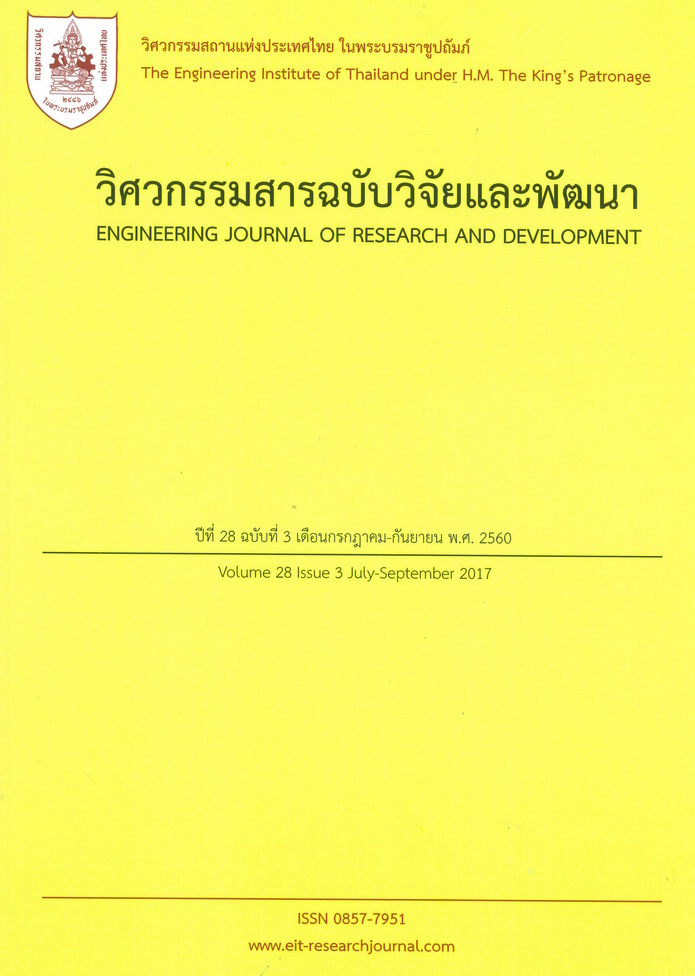การประเมินพื้นที่ที่เหมาะสมต่อการพัฒนาเป็นเมืองอุตสาหกรรมเชิงนิเวศ โดยการประยุกต์ใช้ระบบสารสนเทศภูมิศาสตร์ และเทคนิคกระบวนการลำดับชั้นเชิงวิเคราะห์ กรณีศึกษาในเขตพื้นที่จังหวัดสมุทรปราการ
Main Article Content
Abstract
งานวิจัยนี้มีวัตถุประสงค์เพื่อศึกษาหาลำดับความสำคัญของปัจจัยที่ใช้เป็นตัวชี้วัด และวิเคราะห์หาพื้นที่ที่เหมาะสมต่อการพัฒนาเป็นเมืองอุตสาหกรรมเชิงนิเวศ โดยเริ่มจากศึกษาเอกสารและงานวิจัยที่เกี่ยวข้องสำหรับกำหนดปัจจัยที่ใช้เป็นตัวชี้วัดและเกณฑ์การกำหนดในการวิเคราะห์พื้นที่เป้าหมาย กำหนดได้ 7 ปัจจัย ได้แก่ ปัจจัยการรวมกลุ่มของอุตสาหกรรมประเภทเดียวกัน ปัจจัยความหนาแน่นของโรงงานอุตสาหกรรม ปัจจัยการเข้าถึงพื้นที่สวนสาธารณะและแหล่งนันทนาการ ปัจจัยการได้รับมาตรฐานด้านสิ่งแวดล้อม ปัจจัยการคมนาคมในโซ่อุปทาน ปัจจัยพื้นที่ที่มีข้อร้องเรียน และปัจจัยพื้นที่เสี่ยงต่อภัยพิบัติทางธรรมชาติ จากนั้นออกแบบแบบสอบถามตามวิธีของกระบวนการลำดับชั้นเชิงวิเคราะห์ (Analysis Hierarchy Process: AHP) ให้ผู้เชี่ยวชาญในสาขาที่เกี่ยวข้อง 6 คน ประเมินแบบสอบถาม แล้วนำค่าคะแนนที่ได้มาประมวลผลร่วมกับการวิเคราะห์เชิงพื้นที่ด้วยระบบสารสนเทศภูมิศาสตร์ (Geographic Information System: GIS) จากผลการวิจัย พบว่า ปัจจัยตัวชี้วัดที่มีความสำคัญต่อการพัฒนาเป็นเมืองอุตสาหกรรมเชิงนิเวศมากที่สุด คือ ปัจจัยการได้รับมาตรฐานด้านสิ่งแวดล้อม มีค่าน้ำหนักคะแนนความสำคัญ 0.225 ได้บริเวณพื้นที่ที่มีความเหมาะสมต่อการพัฒนาเป็นเมืองอุตสาหกรรมเชิงนิเวศ 4 ตำแหน่ง โดยบริเวณพื้นที่ที่มีความเหมาะสมมากที่สุด คือ พื้นที่ A2 ครอบคลุมบริเวณตำบลท้ายบ้านในเขตอุตสาหกรรมที่ศึกษาในจังหวัดสมุทรปราการ ซึ่งมีขนาดพื้นที่ประมาณ 1,635.70 ไร่ คิดเป็น 3.64% ของพื้นที่ทั้งหมด ซึ่งกรอบแนวคิดในการกำหนดปัจจัย เทคนิคที่ใช้ และวิธีการวิจัยนี้ จะเป็นประโยชน์อย่างยิ่งต่อการนำไปใช้เป็นแนวทางในการหาพื้นที่ที่เหมาะสมต่อการพัฒนาเป็นเมืองอุตสาหกรรมเชิงนิเวศในพื้นที่อื่นๆ ต่อไป
SITE SUITABILITY EVALUATION FOR ECO INDUSTRIAL TOWN USING GIS AND AHP TECHNIQUE: A CASE STUDY IN SAMUTPRAKARN PROVINCE
This research aims to set priorities of seven factors effecting the development of Eco-Industrial town areas. The best area based on these factors would be shown. The seven factors analysed in this study include the degree of industrial cluster, industrial density, accessing to green and recreation area, number of factory certified by environmental standards, accessing to main roads, areas with degree of complaints, and areas with natural disasters risk. A municipality in Samutprakarn province was selected as a case study. The questionnaire was established based on the Analytic Hierarchy Process (AHP) techniques and the questions were answered by six environmental experts. As a multicriteria analysis in land suitability analysis, an integration of Geographic Information System (GIS) and AHP was chosen and examined in this study. The results showed that the most important factor is the number of factories certified by environmental standards, with weight 0.225. The results showed that the municipality region could be classified into four sub-areas and the most suitable area for the initial development that met the Eco-Industrial town's requirements is A2. A2 is a Taiban Sub-district covering 2,617,120 square meters or 3.64% of the total area. We believe that our proposed framework for integrating of GIS to AHP can help decision makers determine which one will best suit their goals.
Article Details
The published articles are copyright of the Engineering Journal of Research and Development, The Engineering Institute of Thailand Under H.M. The King's Patronage (EIT).

